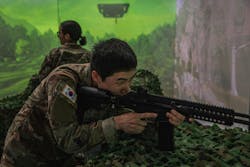Air Force reaches out to industry for enabling technologies to improve weapons simulation and evaluation
EGLIN AIR FORCE BASE, Fla. – The U.S. Air Force is approaching industry for enabling technologies to improve simulation and evaluation of current and future weapons in realistic and non-destructive flight and mission simulations.
Officials of the Air Force 96th Test Wing's 782nd Test Squadron at Eglin Air Force Base, Fla., issued a solicitation (FA2486-25-X-0001) last week for the Hardware-in-the-loop of Advanced Navigation & Guidance Sensors (HANGS) project.
Hardware-in-the-loop simulations will provide high-fidelity performance assessment for system development, risk mitigation prior to live flight tests, testing scenarios that are not feasible for live flight, and evaluation of candidate components and technologies for system improvements, Air Force experts say.
HANGS seeks enabling technologies to help evaluate the feasibility of seekers and sensors; position, navigation, and timing (PNT); guidance, navigation, and control; RF data links; mission computers; and flight software. Prototypes should relate to missile offense, missile defense, and strategic weapons.
Technology areas of interest
HANGS has four technology areas of interest: dynamic real-time multispectral scene generation and projection/injection systems; midcourse and navigation environment simulation; datalink and radio communications simulation; and high-frame-rate real-time simulation.
Dynamic real-time multispectral scene generation and projection seeks to render band-specific imagery into one or more sensors, either by free-space projection, or by digital injection.
Imagery should involve infrared, ultraviolet, visible-light, and RF bands; multi-object, clutter, and background scenes; target and background modeling; and compatibility with industry standards.
Midcourse and navigation environment simulation involves real-time projection of Global Navigation Satellite System (GNSS) and alternative PNT solutions, including propagation, environmental, and countermeasure effects.
Radio communications
Datalink and radio communications simulation involves multi-protocol datalink and radio communication among several real and simulated guided weapons, including propagation, environmental, and countermeasure effects; simulation of large networks, network loading, and transport; and simulation of commercial low-Earth-orbit satellite communications networks.
High-frame-rate real-time simulation involves computers able to carry out correlated real-time flight simulations for several systems at very high frame rates, including graphics processors. Several contract awards are expected.
Companies interested should email enhanced white papers no later than 18 Aug. 2025 to the Air Force's Heather Stiles at [email protected]. More information is online at https://sam.gov/opp/45dc6e7cbc8c4601a116ed931eb76c0e/view.
About the Author
John Keller
Editor-in-Chief
John Keller is the Editor-in-Chief, Military & Aerospace Electronics Magazine--provides extensive coverage and analysis of enabling electronics and optoelectronic technologies in military, space and commercial aviation applications. John has been a member of the Military & Aerospace Electronics staff since 1989 and chief editor since 1995.
